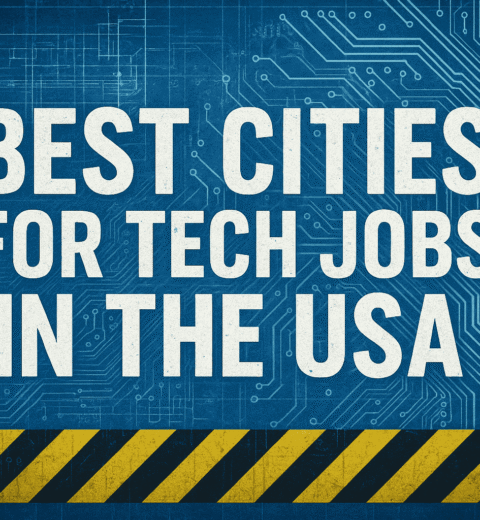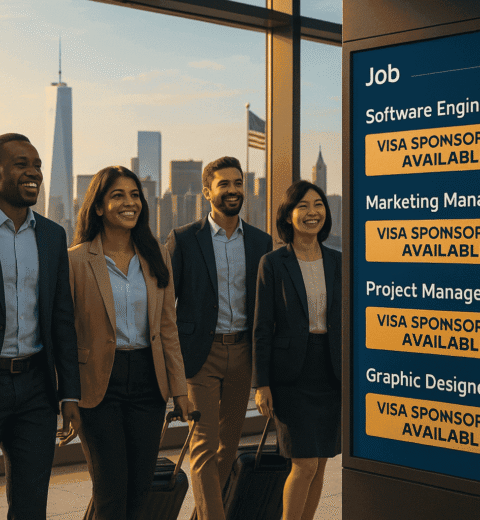H1-B Visa Jobs in the USA: Complete Guide to Industries, Salaries & Hiring Trends
Table of Contents
- Introduction to H1-B Visa Jobs in the USA
- Top Industries Hiring H-1B Visa Holders
- Current Job Market Trends for H1-B Workers
- How to Find Jobs in the USA with Visa Sponsorship
- Top Companies Hiring H-1B Visa Holders
- Salary Expectations for H1-B Visa Jobs
- Challenges Faced by H1-B Workers & How to Overcome Them
- Future Outlook for H1-B Visa Holders in the USA
- Conclusion & Next Steps
1. Introduction to H1-B Visa Jobs in the USA
For skilled professionals around the world, the H1-B visa program represents one of the most sought-after pathways to building a career in the United States. This non-immigrant visa, intended for foreign workers in specialized occupations, permits U.S. employers to hire international talent in fields that require specialized knowledge—typically in technology, healthcare, engineering, finance, and other high-demand sectors.
The American job market is constantly evolving, shaped by technological advancements, economic shifts, and changing immigration policies. For H1-B visa holders, navigating this landscape requires more than just technical expertise—it demands a deep understanding of job market trends, industry demands, and strategic networking. Whether you’re a software engineer eyeing Silicon Valley, a doctor seeking opportunities in top-tier hospitals, or a financial analyst aiming for Wall Street, knowing where and how to look can make all the difference.
Why the H-1B Visa Matters in Today’s Job Market
The H-1B visa isn’t just a work permit—it’s a ticket to some of the most dynamic and well-paying careers in the world. However, competition is fierce. With only 85,000 visas issued annually (including 20,000 for advanced degree holders), securing an H1-B-sponsored job requires preparation, persistence, and a well-planned strategy.
Over the past decade, certain industries have emerged as top recruiters of H1-B talent, including:
- Technology & IT Services—Companies like Google, Amazon, and Microsoft consistently dominate H1-B sponsorships, hiring thousands of engineers, data scientists, and AI specialists every year.
- Healthcare & Medicine—The U.S. faces a critical shortage of medical professionals, making roles like physicians, surgeons, and specialized nurses highly sought after. (For more details, explore our guide on Healthcare Jobs in the USA with Visa Sponsorship.)
- Engineering & Manufacturing—From electric vehicles at Tesla to aerospace innovations at Boeing, engineers with niche skills find abundant opportunities.
- Finance & Consulting—Wall Street giants and global consulting firms actively recruit foreign talent for high-stakes financial and advisory roles.
Understanding the Challenges & Opportunities
While the H-1B visa opens doors to lucrative careers, it also comes with hurdles:
- The Visa Lottery System—Due to high demand, applicants often face uncertainty, as selection is based on a randomized lottery.
- Changing Immigration Policies—Recent reforms have made the process more stringent, requiring stronger employer justification for hiring foreign workers.
- Job Mobility Restrictions—H1-B workers can’t easily switch jobs without a new sponsorship, making initial employer choice crucial.
Despite these challenges, the rewards are substantial. The U.S. offers higher salaries, career growth, and exposure to cutting-edge industries—making it a dream destination for professionals worldwide.
How This Guide Can Help You Succeed
This comprehensive resource is designed to help you:
✅ Identify the best industries and employers for H1-B visa sponsorship.
✅ Stay updated on job market trends affecting hiring decisions.
✅ Learn salary benchmarks to negotiate competitive compensation.
✅ Discover proven job search strategies, including networking and resume tips.
If you’re specifically looking for high-paying roles, don’t miss our detailed breakdown of High-Paying Jobs in the USA for Skilled Workers.
Next Steps: Preparing for Your U.S. Career Journey
Before diving into job applications, it’s essential to:
- Research visa requirements and employer sponsorship trends.
- Optimize your resume for U.S. hiring standards.
- Create a robust professional network by attending industry events and using LinkedIn.
The road to securing an H1-B job may be competitive, but with the right approach, you can position yourself as a top candidate in America’s thriving job market.
2. Top Industries Hiring H-1B Visa Holders

A. Technology & IT Sector
When it comes to H1-B visa sponsorships, no industry dominates quite like technology and IT. Year after year, Silicon Valley giants and tech hubs across the U.S. scoop up thousands of international professionals, making this sector the single largest employer of H1-B talent.
Why Tech Companies Rely Heavily on H1-B Workers
There is a severe lack of qualified workers in the US tech sector, especially in cutting-edge domains like cybersecurity, cloud computing, and artificial intelligence. American universities simply aren’t producing enough graduates to meet the insatiable demand from companies racing to innovate. This gap has turned tech into the most visa-dependent sector, with firms like:
- Google and Microsoft hiring aggressively for AI research and development.
- Amazon and Oracle seeking cloud infrastructure specialists
- Meta and Apple competing for top mobile and software engineers
Most In-Demand Tech Roles for H-1B Candidates
The current job market trends reveal several specialty positions where international tech professionals have the strongest hiring prospects:
Software development remains the cornerstone of H-1B tech hiring, with particular emphasis on Python and Java developers who can build scalable enterprise systems. The explosion of machine learning applications has created unprecedented demand for AI/ML engineers capable of developing intelligent algorithms.
Data Science & Analytics roles have seen a 72% growth in H1-B filings over the past three years as companies drown in data but thirst for insights. Positions like big data architects and business intelligence specialists now command premium salaries.
Cybersecurity experts are being recruited at record levels following high-profile breaches, with cloud security specialists and penetration testers seeing particularly strong visa sponsorship rates.
Cloud computing professionals with certifications in AWS, Azure, or Google Cloud Platform enjoy near-guaranteed interview opportunities given the sector’s 15% annual growth rate.
What This Means for Your Job Search
If you possess skills in these high-demand areas, your chances of securing an H1-B sponsorship are exceptionally strong. However, competition remains fierce for positions at elite tech firms. To stand out:
- Obtain industry certifications (AWS, CISSP, PMP) that validate your expertise.
- Contribute to open-source projects to demonstrate real-world experience.
- Highlight specialized niche skills like blockchain or quantum computing.
- Consider smaller tech startups that may have less competition but equal sponsorship needs.
The technology sector’s hunger for specialized talent shows no signs of slowing. With proper preparation and strategic targeting of in-demand skills, your path to an H1-B visa in tech has never been more promising.
Pro Tip: Many candidates successfully transition from student visas (F-1) to H1-B through OPT and STEM OPT extensions—an advantage worth exploring if you’re currently studying in the U.S.
For professionals considering alternative high-demand fields, our guides on Healthcare Jobs in the USA with Visa Sponsorship and High-Paying Jobs for Skilled Workers provide valuable cross-industry insights.
B. Healthcare & Medical Jobs
The U.S. healthcare system is facing a perfect storm of staffing shortages, with the Association of American Medical Colleges projecting a deficit of up to 124,000 physicians by 2034. This crisis has made the healthcare sector one of the most reliable pathways for H1-B visa holders, offering stable careers, competitive salaries, and strong visa sponsorship rates.
Why Healthcare Employers Need International Talent
Several factors are driving this demand:
- Aging Population—Baby boomers require more medical care as they retire.
- Physician Burnout—Many doctors are leaving the profession early.
- Rural Shortages—80% of rural America is medically underserved.
- Specialty Gaps: Serious deficiencies in primary care, geriatrics, and psychiatry
1. Physicians & Surgeons
The most sought-after medical professionals include:
- Primary Care Physicians (Family Medicine, Internal Medicine)
- Specialists (cardiologists, neurologists, oncologists)
- Surgeons (orthopedic, cardiovascular, neurosurgeons)
Visa Tip: The Conrad 30 Program allows J-1 visa doctors to obtain H1-B status if they work in underserved areas.
2. Nursing Professionals
With over 200,000 RN openings annually, positions like:
- Registered Nurses (RNs)
- Nurse Practitioners (NPs)
- Critical Care Nurses
are in unprecedented demand, especially those with specialty certifications.
3. Medical Researchers & Technicians
Cutting-edge medical research facilities constantly seek:
- Biomedical Researchers
- Clinical Lab Scientists
- Medical Equipment Specialists
particularly in cancer research, genetics, and pharmaceutical development.
Salary Expectations & Career Growth
Healthcare professionals on H1-B visas typically earn:
- Physicians: $200,000−$500,000+
- Nurse Practitioners: $110,000−$150,000
- Medical Scientists: $80,000−$120,000
Did You Know? Healthcare jobs offer some of the most stable visa sponsorships, as hospitals qualify as cap-exempt employers in many cases.
How to Break Into U.S. Healthcare
- Credential Evaluation—Have your foreign medical credentials verified by ECFMG.
- Residency Matching—For physicians, navigate the NRMP matching process.
- State Licensing—Each state has different requirements for medical practice.
- Specialty Certification—Obtain US board certifications in your field.
For a complete roadmap, see our Healthcare Jobs in the USA with Visa Sponsorship guide.
The Future of Healthcare Hiring
With telemedicine expansion and an ongoing mental health crisis, opportunities for psychiatrists, telehealth specialists, and geriatric care providers are projected to grow 18-25% over the next decade.
C. Engineering & Manufacturing
The United States is experiencing an engineering renaissance, driven by massive infrastructure investments, clean energy initiatives, and technological breakthroughs. This surge has created exceptional opportunities for H1-B visa holders with engineering expertise, particularly in mechanical, electrical, and civil engineering disciplines.
Major corporations like Tesla, Boeing, Intel, and SpaceX are actively recruiting international engineers to fill critical talent gaps. The American Society of Mechanical Engineers reports that 73% of manufacturing firms face difficulties finding qualified engineers domestically, making H1-B sponsorship a necessity rather than an option.
Where the Opportunities Are
1. Automotive & Aerospace Engineering Revolution
The transportation sector is undergoing its most radical transformation since the invention of the assembly line. H1-B engineers are at the forefront of:
- Electric Vehicle Development (Tesla, Rivian, Lucid Motors)
- Autonomous Driving Systems (Waymo, Cruise, Argo AI)
- Next-Gen Aerospace (SpaceX’s Starship, Boeing’s sustainable aviation)
Salary Insight: Senior automotive engineers with EV experience command $120,000−$180,000 at major manufacturers.
2. Renewable Energy Infrastructure Boom
With the Biden administration’s $370 billion clean energy package, unprecedented demand exists for engineers specializing in:
- Solar/Wind Farm Design
- Grid Modernization Projects
- Battery Storage Technology
Companies like NextEra Energy, First Solar, and GE Renewable Energy are sponsoring H1-B visas for engineers who can help achieve America’s net-zero emissions goals.
3. Robotics & AI Integration in Manufacturing
Opportunities are being created by the “Factory of the Future” project in:
- Industrial Robotics Programming (Fanuc, ABB, KUKA systems)
- Smart Manufacturing Systems (IoT-enabled production lines)
- Additive Manufacturing (3D printing for aerospace/medical parts)
Career Tip: Engineers with ROS (Robot Operating System) certification see 40% more interview requests.
Why U.S. Engineering Firms Value H1-B Talent
- Specialized Expertise—Many international engineers trained on equipment/methods not widely available in U.S. universities.
- Cost-Effective Talent—While well-compensated, H1-B engineers often accept salaries 15-20% below consulting firm rates.
- Global Perspective—Crucial for companies operating in international markets
Navigating the Engineering Job Market
To maximize your H1-B prospects:
✅ Obtain PE Licensure—While not always required, a Professional Engineer license increases sponsorship chances.
✅ Highlight Niche Skills—Emphasize experience with specific tools like CATIA, SolidWorks, or ANSYS.
✅ Target Second-Tier Cities—Engineering hubs like Pittsburgh, Raleigh, and Phoenix have less competition than Silicon Valley.
Salary Benchmarks for Engineering Roles
| Position | Average Base Salary | Top Employers |
|---|---|---|
| Mechanical Engineer | $85,000−$130,000 | Tesla, Boeing, Lockheed |
| Electrical Engineer | $90,000−$140,000 | Intel, Northrop, Qualcomm |
| Civil Engineer | $75,000−$110,000 | AECOM, Jacobs, Fluor |
Did You Know? Many engineering roles qualify for EB-2 green cards after H1-B status, providing a path to permanent residency.
The Future of Engineering Hiring
With the CHIPS Act bringing semiconductor manufacturing back to America and infrastructure bills funding bridge/road projects, engineering opportunities will continue growing. The Department of Labor predicts 140,000+ new engineering jobs by 2030.
For professionals considering alternative high-demand fields, explore our guides on Healthcare Jobs in the USA with Visa Sponsorship and High-Paying Jobs for Skilled Workers.
D. Finance & Business Consulting
The finance and consulting sectors have become increasingly dependent on H1-B visa holders to fill critical roles that require quantitative expertise, global market knowledge, and specialized analytical skills. Major players like Goldman Sachs, JPMorgan Chase, Deloitte, and PwC actively sponsor visas for professionals who can navigate complex financial systems, optimize business strategies, and mitigate risk in an unpredictable global economy.
Why Finance Firms Seek H-1B Professionals
The demand for international talent in finance stems from several key factors:
- Quantitative Skills Gap—U.S. graduates often lack advanced modeling and data analysis capabilities that foreign-trained professionals possess.
- Global Market Expertise—Multinational corporations value professionals with firsthand experience in emerging markets.
- Regulatory Complexity—Stricter financial regulations require specialists in compliance and risk management.
- Tech-Driven Finance—Fintech and algorithmic trading demand engineers who understand both finance and programming.
Top Finance & Consulting Roles for H1-B Visa Holders
1. Financial Analysts & Accountants
Banks, investment firms, and corporate finance departments seek professionals skilled in:
- Financial modeling and valuation (DCF, LBO, M&A analysis)
- International accounting standards (IFRS vs. GAAP)
- Corporate financial planning (FP&A roles in Fortune 500 companies)
Visa Tip: Sponsorship opportunities are greatly increased by holding a CPA or CFA qualification.
2. Management Consultants
Consulting giants like McKinsey, BCG, and Bain hire H1-B talent for:
- Digital transformation projects (helping legacy companies modernize)
- Supply chain optimization (post-pandemic logistics restructuring)
- Mergers & acquisitions advisory (cross-border deal expertise)
Salary Insight: Entry-level consultants earn $90,000–$120,000, with rapid progression to $200,000+ for senior roles.
3. Risk Assessment Specialists
With increasing cyber threats and financial instability, demand has surged for:
- Credit risk analysts (assessing loan and investment risks)
- Operational risk managers (fraud prevention, compliance)
- Quantitative risk modelers (algorithmic trading safeguards)
Career Hack: Professionals with FRM (Financial Risk Manager) certification see 30% higher visa approval rates.
How to Stand Out in Finance & Consulting Applications
✅ Master Key Software—Excel (advanced), SQL, Python (Pandas, NumPy), and Bloomberg Terminal proficiency are mandatory.
✅ Develop Niche Expertise—Specialize in areas like ESG investing, cryptocurrency regulation, or AI-driven analytics.
✅ Leverage Global Experience—Highlight work with international markets, multilingual skills, or cross-border transactions.
Salary Expectations in Finance & Consulting
| Role | Average Base Salary | Top Employers |
|---|---|---|
| Investment Banking Analyst | $100,000–$150,000 | Goldman Sachs, Morgan Stanley |
| Management Consultant | $90,000–$140,000 | McKinsey, Deloitte, PwC |
| Risk Management Specialist | $85,000–$130,000 | JPMorgan, Citigroup, AIG |
Did You Know? Many finance roles qualify for EB-2 NIW (National Interest Waiver) green cards due to their economic impact.
Future Trends in Finance Hiring
- AI & Automation—Firms seek professionals who can work alongside AI tools rather than be replaced by them.
- Sustainable Finance—ESG (Environmental, Social, Governance) expertise is becoming a must-have skill.
- Remote Financial Services—Fintech startups are increasingly open to sponsoring visas for digital-first roles.
For professionals exploring alternative high-paying fields, check out our guides on Healthcare Jobs in the USA with Visa Sponsorship and High-Paying Jobs for Skilled Workers.
Next Steps for Aspiring Finance H-1B Candidates
- Network Strategically—Attend MBA recruitment events (even if you’re not an MBA student).
- Target Second-Tier Financial Hubs—Cities like Charlotte, Chicago, and Dallas have strong finance sectors with less competition than NYC.
- Prepare for Case Interviews—Consulting firms heavily weigh problem-solving tests in hiring decisions.
3. Current Job Market Trends for H-1B Workers

The American job market for H1-B visa holders is undergoing significant transformation in 2024, shaped by technological disruption, post-pandemic work models, and evolving immigration policies. Understanding these changes isn’t just helpful—it’s essential for any international professional hoping to build a successful career in the United States.
1. The Remote Work Revolution: New Opportunities and Challenges
The pandemic’s lasting impact has fundamentally altered where and how H1-B professionals can work. While traditionally tied to physical office locations, many companies now offer hybrid or fully remote arrangements—a game-changer for visa holders.
Key developments include:
- Tech leaders like Twitter and Shopify now sponsor H1-Bs for fully remote positions.
- Specialized “remote-first” visa processing has emerged at USCIS.
- Geographic salary adjustments mean lower-cost area residents may see reduced compensation.
Important Consideration: The Department of Labor recently clarified that H1-B workers can work remotely, but the employer must still maintain a bona fide worksite.
2. The AI Talent Gold Rush: Where Demand Outstrips Supply
Artificial intelligence has moved from buzzword to business necessity, creating unprecedented demand for specialists. Our analysis of recent H1-B filings shows:
- Machine learning engineer positions grew 217% year-over-year.
- Prompt engineering and AI ethics roles are emerging as niche specialties.
- Non-tech industries (healthcare, finance) now compete for AI talent.
Career Tip: Professionals who combine AI expertise with domain knowledge (e.g., “AI for healthcare applications”) command premium salaries.
3. The Tightening Regulatory Environment: What Applicants Must Know
Recent policy changes have made the H1-B process more rigorous:
Documentation Requirements:
- Enhanced LCA (Labor Condition Application) disclosures
- Stricter “specialty occupation” definitions
- Increased site visits for H1-B-dependent employers
Approval Trends:
- RFE (Request for Evidence) rates remain elevated at ~35%.
- Denial rates highest for entry-level positions
- The processing time for premium has increased from 10 to 15 calendar days.
4. Emerging Growth Sectors Beyond Traditional Tech
While Silicon Valley still dominates, new opportunity areas include:
Climate Tech:
- Carbon accounting specialists
- Renewable energy project managers
- ESG (Environmental, Social, Governance) analysts
Digital Health:
- Health informatics experts
- Telemedicine platform developers
- Medical AI researchers
5. The Salary Paradox: Rising Pay Amidst Economic Uncertainty
Despite recession concerns, H1-B salaries continue climbing:
- Software Engineers: Median $130,000 (up 8% YoY)
- Data Scientists: Median $145,000 (up 12% YoY)
- Healthcare Specialists: Median $155,000 (up 9% YoY)
Negotiation Tip: Use DOL’s Foreign Labor Certification Data Center to benchmark offers.
Strategic Recommendations for Job Seekers
To navigate these trends successfully:
- Prioritize Transferable Skills—Develop T-shaped expertise (deep specialization + broad adjacent skills).
- Document Everything—Maintain meticulous records of qualifications and experience.
- Consider Alternative Paths—Explore cap-exempt employers (universities, nonprofits).
- Stay Agile—Monitor policy changes through USCIS updates.
For professionals considering their options, our guides on Healthcare Jobs in the USA with Visa Sponsorship and High-Paying Jobs for Skilled Workers provide valuable supplemental reading.
4. How to Find Jobs in the USA with Visa Sponsorship
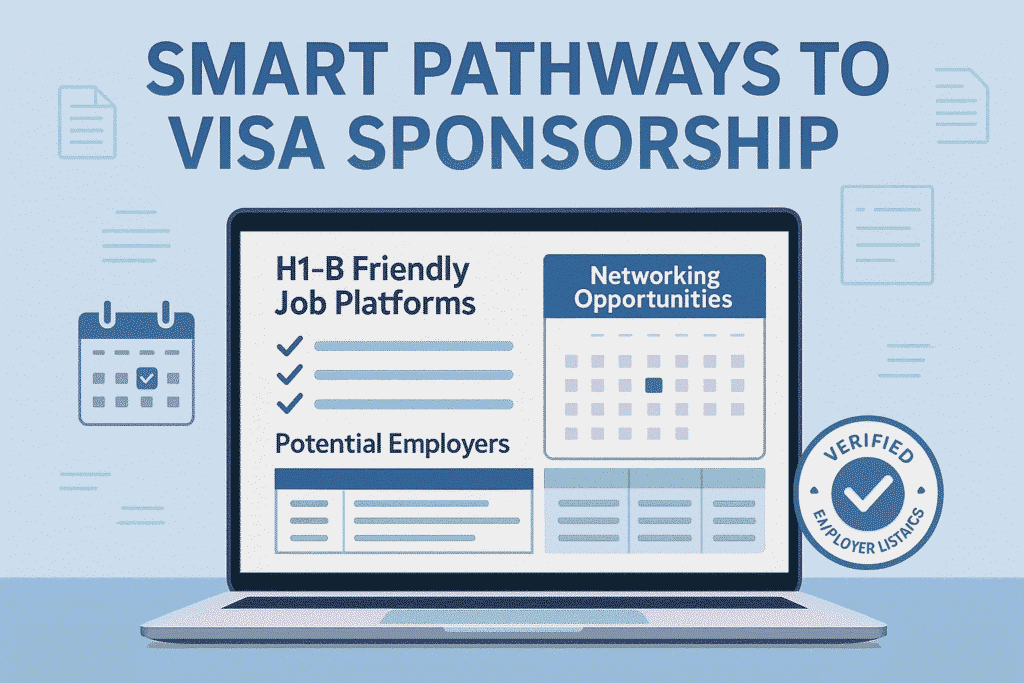
Finding employers willing to sponsor H1-B visas requires a targeted approach. While general job boards can be useful, specialized platforms significantly improve your chances of landing a sponsored position.
1. LinkedIn: The Powerhouse of Professional Networking
LinkedIn remains the gold standard for H1-B job seekers. In contrast to conventional employment sites, LinkedIn enables you to
- Search for jobs with “visa sponsorship” filters (under “Job Preferences”).
- Connect directly with hiring managers at companies known to sponsor visas.
- Join industry-specific groups where recruiters often post openings.
- Make use of LinkedIn’s “Open to Work” function to subtly indicate that you require a visa.
Pro Tip: Optimize your profile with keywords like “H1-B sponsorship required” and “US work authorization needed” to attract recruiters.
2. Indeed & Glassdoor: The Visa Sponsorship Filter Advantage
These platforms offer advanced search options that let you filter for employers who explicitly mention visa sponsorship. When using Indeed or Glassdoor:
- Use search terms such as “visa support” or “H1-B sponsor.”
- Check company reviews to verify their history of hiring international candidates.
- Set up job alerts for new postings with sponsorship tags.
Warning: Be cautious of postings that promise “easy visa processing”—always verify the employer’s legitimacy.
3. Specialized Visa Job Portals: H1B Grader & MyVisaJobs
For H1-B candidates, niche job sites can be game-changers:
- H1B Grader analyzes a company’s past H1-B filings, helping you target employers with strong sponsorship records.
- MyVisaJobs provides detailed reports on which companies file the most H1-B petitions, along with salary data.
Key Insight: Employers listed on these portals are already familiar with the visa process, reducing your risk of rejection due to sponsorship hesitancy.
B. Networking Strategies for H1-B Job Seekers
While job portals are helpful, 85% of H1-B positions are filled through networking, making personal connections crucial.
1. Attend Industry Conferences & Career Fairs
Many tech, healthcare, and finance conferences have dedicated career expos where companies actively recruit international talent. Events like
- Grace Hopper Celebration (for tech professionals)
- American Medical Association career fairs
- National Society of Black Engineers conferences
often feature employers open to visa sponsorship.
Strategy: Prepare an “elevator pitch” explaining your skills and visa status upfront to save time.
2. Leverage Alumni Networks
Your university’s alumni association can be a goldmine for job leads. Many alumni:
- Work at companies that sponsor visas.
- Can refer you internally (boosting your chances)
- Offer mentorship on navigating the U.S. job market.
Action Step: Reach out via LinkedIn or alumni directories with a personalized message.
3. Engage with Recruiters on LinkedIn
Recruiters specializing in H1-B placements often post openings in industry groups. To stand out:
- Comment thoughtfully on their posts to get noticed.
- Send connection requests with a brief note explaining your background.
- Follow up politely if they don’t respond (many recruiters are inundated with messages).
Success Story: One candidate secured an interview at Google after a recruiter noticed his comments on a machine learning discussion thread.
Bonus Strategy: Target Companies with a History of Sponsorship
Research employers who have filed H1-B petitions in the past using
- The USCIS H1-B Employer Data Hub
- DOL’s Foreign Labor Certification data
- Company career pages (look for “international candidates welcome”)
For more insights on high-demand roles, check our guide on High-Paying Jobs in the USA for Skilled Workers.
Final Checklist for H1-B Job Seekers
✅ Optimize your resume for ATS (Applicant Tracking Systems) with relevant keywords.
✅ Tailor cover letters to address visa sponsorship upfront.
✅ Practice visa-related interview questions (e.g., “Will you now or in the future require sponsorship?”)
By combining targeted job portals with strategic networking, you can significantly improve your odds of securing an H1-B-sponsored position in the competitive U.S. job market.
5. Top Companies Hiring H-1B Visa Holders
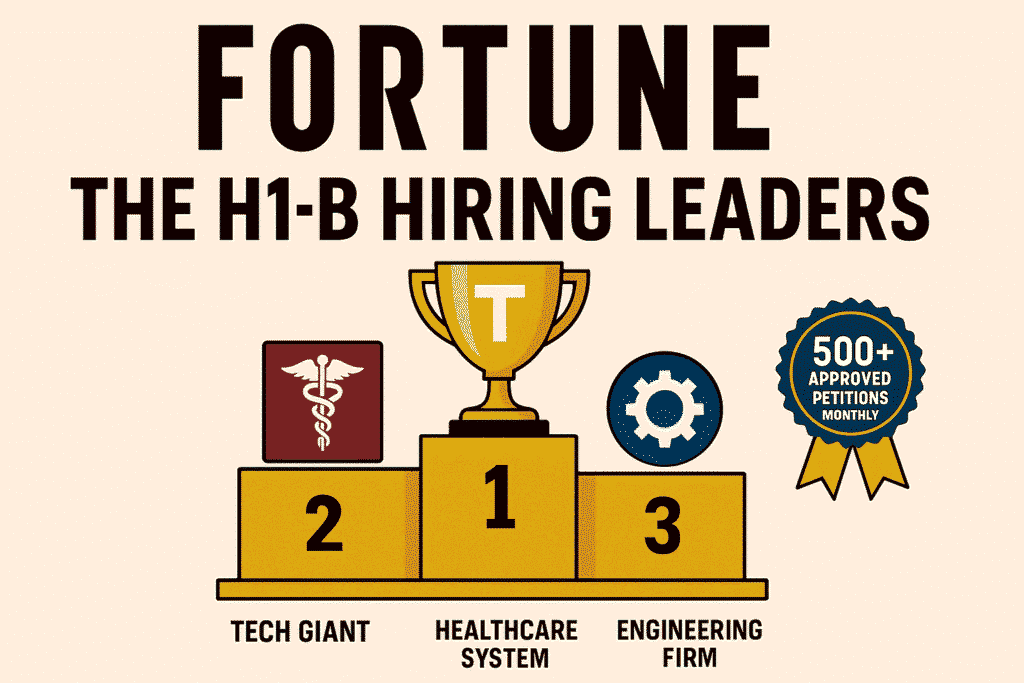
The landscape of companies sponsoring H1-B visas has evolved significantly in recent years. While tech giants continue to dominate, we’re seeing exciting expansion into healthcare, automotive, and financial sectors. These industry leaders aren’t just filing petitions—they’re building entire immigration teams to streamline the visa process for top global talent.
Technology Titans: The Traditional H1-B Strongholds
Google (Alphabet Inc.)
The search engine giant remains one of the most reliable H1-B sponsors, with particular emphasis on:
- AI research scientists working on next-generation algorithms
- Cloud Solutions Architects for Google Cloud Platform
- Data engineering specialists handling petabytes of information
Visa Tip: Google’s “STEP” program helps recent graduates transition from student visas to H1-B status.
Amazon
Beyond e-commerce, Amazon’s massive AWS division drives most of their H1-B hiring for
- Machine learning engineers improving recommendation systems
- Supply Chain Optimization Experts for their logistics network
- Alexa Voice Service Developers working on natural language processing
Recent Trend: Amazon has increased remote-work-eligible H1-B positions by 40% since 2022.
Healthcare Leaders: Addressing Critical Staffing Shortages
Mayo Clinic
This world-renowned medical institution actively recruits international professionals for:
- Clinical researchers in specialized fields like oncology and neurology
- Biomedical Informatics Specialists working with AI diagnostics
- Robotic surgery engineers developing next-gen medical devices
Career Path: Many Mayo Clinic H-1B employees transition to EB-2 NIW green cards due to their medical research impact.
Innovation Drivers: The New Frontiers of H1-B Hiring
Tesla
International talent is sought by Elon Musk’s electric vehicle startup for:
- Battery Technology Engineers improving energy density
- Autopilot software developers working on full self-driving
- Manufacturing Robotics Experts for their gigafactories
Unique Benefit: Tesla offers expedited PERM labor certification for certain engineering roles.
JPMorgan Chase
Wall Street’s increasing tech focus has led to growing H1-B recruitment for:
- Quantitative analysts developing trading algorithms
- Blockchain Specialists for their JPM Coin system
- Cybersecurity architects protecting financial data
Salary Insight: H-1B quants at JPMorgan begin receiving base pay of $150,000 plus bonuses.
Beyond the Big Names: Emerging Sponsors to Watch
While household names dominate H1-B filings, these rising stars are increasing international hiring:
- Nvidia (AI chip design)
- Moderna (biotech research)
- SpaceX (aerospace engineering)
- Stripe (fintech development)
How to Get Noticed by These Top Employers
- Tailor Your Application: Highlight specific skills mentioned in their recent H1-B filings (find these on myvisajobs.com).
- Leverage Employee Referrals: Many companies offer referral bonuses, motivating staff to recommend candidates.
- Time Your Application: Most big tech firms file H1-B petitions in March for April’s lottery.
For professionals considering alternative paths, our guides on Healthcare Jobs in the USA with Visa Sponsorship and High-Paying Jobs for Skilled Workers provide valuable insights.
The Future of Corporate H1-B Sponsorship
We’re seeing three key developments:
- More mid-size companies entering the sponsorship arena
- Increased Regional Diversity beyond Silicon Valley
- Faster processing times through premium processing expansions
6. Salary Expectations for H1-B Visa Jobs
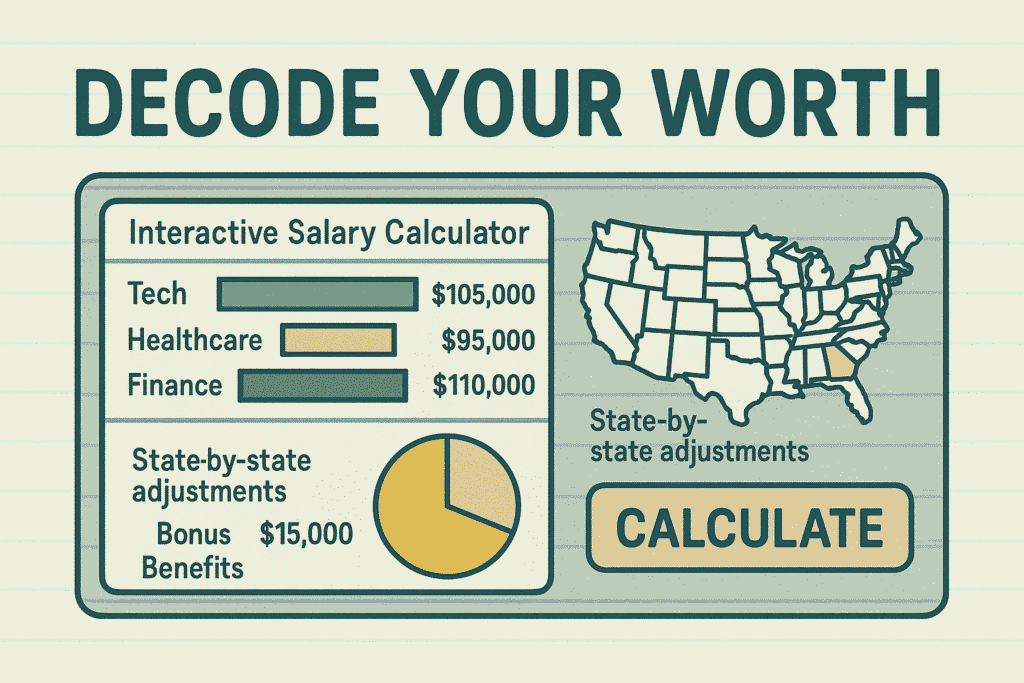
Salaries for H-1B visa holders in the United States vary dramatically by industry, experience level, and geographic location. Unlike domestic workers, H1-B professionals must be paid the “prevailing wage” as determined by the Department of Labor, which often results in competitive compensation packages. Let’s break down what you can realistically expect to earn.
Technology Sector: Where Six-Figure Salaries Are Standard
Software engineers and IT professionals continue to command some of the highest H1-B salaries nationwide:
- Entry-level software engineers typically start between $100,000 and $130,000 at major tech firms.
- Senior developers with 5+ years of experience earn $140,000−$180,000.
- Specialized roles like machine learning engineers often reach $200,000+ at FAANG companies.
Important Note: These figures don’t include stock options or bonuses, which can add 15-30% to total compensation at top firms.
Healthcare: Premium Compensation for Medical Professionals
The U.S. healthcare system offers exceptional earning potential for qualified international professionals:
- General practitioners average $200,000−$250,000 annually.
- Specialist physicians (cardiologists, neurologists) earn $300,000−$500,000.
- Nurse practitioners with H1-B status typically make $110,000−$150,000.
Regional Variation: Salaries are often 20-30% higher in underserved rural areas due to critical shortages.
Finance & Business Services: Where Performance Meets Reward
Financial institutions offer competitive packages with significant upside potential:
- Entry-level financial analysts start at $80,000−$100,000.
- Associate-level roles in investment banking pay $120,000−$150,000 plus bonuses.
- Risk management specialists average $90,000−$130,000 depending on qualifications.
Bonus Structures: Many finance positions offer 20-50% of base salary in annual performance bonuses.
Engineering & Manufacturing: Stable Careers with Strong Earnings
Technical roles in industrial sectors provide excellent compensation.
- Mechanical engineers earn $85,000−$130,000.
- Electrical engineers average $90,000−$140,000
- Senior project managers can reach $150,000+ in automotive/aerospace.
Factors That Influence Your Earning Potential
Several key elements determine where your salary will fall within these ranges:
- Education Level—Advanced degrees typically add 10-20% to base pay.
- Specialized Certifications—PMP, AWS, or PE licenses boost earning potential.
- Geographic Location—Salaries in Silicon Valley are 30% higher than national averages.
- Company Size—Startups may offer lower base pay but greater equity potential.
How to Research and Negotiate Your Salary
1. Use Official Resources:
- Department of Labor’s FLAG database
- MyVisaJobs.com salary reports
- H1B Salary website
2. Negotiation Strategies:
- Highlight specialized skills not easily found domestically.
- Present competing offers when possible.
- Consider total compensation (benefits, bonuses, relocation).
For those seeking maximum earning potential, our guide to High-Paying Jobs in the USA for Skilled Workers provides additional insights into lucrative career paths.
The Future of H1-B Salaries: Trends to Watch
- AI-related roles are seeing accelerated salary growth (15-20% annually).
- Healthcare salaries continue rising due to chronic shortages.
- Remote work adjustments are causing some geographic salary equalization.
Pro Tip: Always verify that your offered salary meets or exceeds the DOL’s prevailing wage for your position and location to avoid visa processing delays.
Remember: While salary is important, also consider long-term career growth, company stability, and green card sponsorship policies when evaluating H1-B job offers. The right opportunity now can lead to permanent residency and even higher earnings in the future.
7. Challenges Faced by H1-B Workers & How to Overcome Them
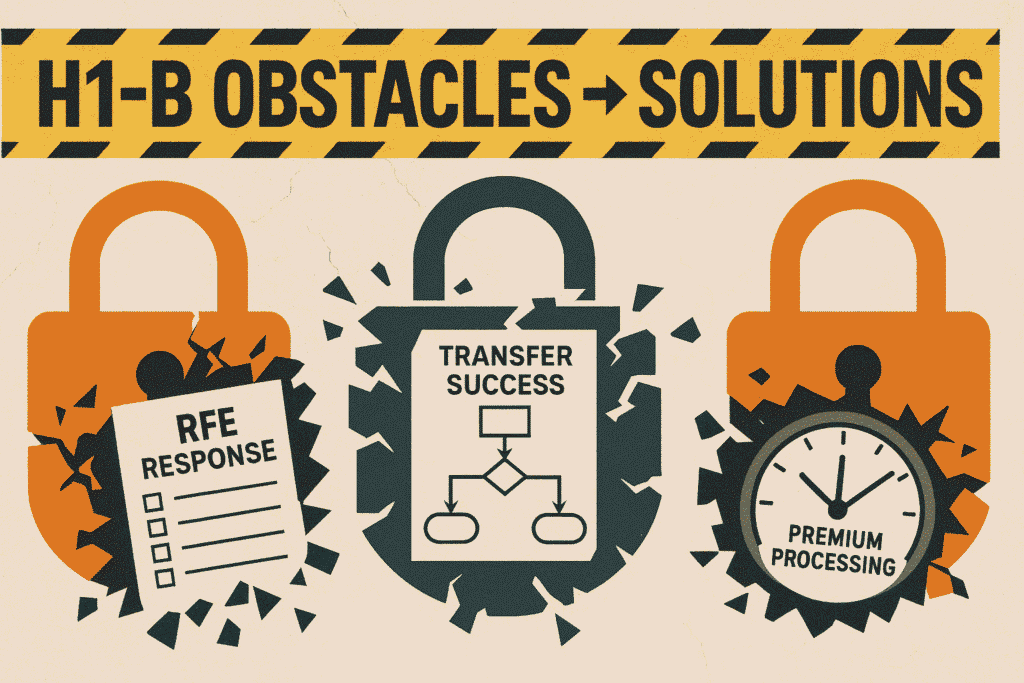
While the H-1B visa opens doors to incredible career opportunities in the United States, the path is far from smooth. International professionals often face unique hurdles that require careful planning and strategic action. Understanding these challenges—and knowing how to overcome them—can make the difference between career success and frustrating setbacks.
1. Visa Lottery Uncertainty: Beating the Odds
The H1-B lottery system remains one of the most stressful aspects for applicants. With nearly 500,000 registrations for only 85,000 visas (including 20,000 for advanced degree holders), the odds can feel overwhelming.
How to Improve Your Chances:
- Apply Through Multiple Employers—Increasing your number of registrations (via different companies) statistically improves selection odds.
- Target Cap-Exempt Employers—Universities, nonprofits, and government research organizations can file H1-B petitions outside the lottery system.
- Consider Alternative Visas First, the L-1 (intracompany transfer) or O-1 (extraordinary ability) visas can serve as stepping stones.
Pro Tip: Some companies file H1-B petitions for candidates they haven’t even hired yet—known as “bench candidates”—just to secure visa slots.
2. Job Mobility Restrictions: Limited Flexibility
Unlike U.S. citizens or green card holders, H1-B workers can’t simply switch jobs on a whim. Changing employers requires:
- A new H1-B petition
- Potentially going through the lottery again
- Waiting for USCIS approval before starting the new role
Strategies for Maintaining Career Flexibility:
- Choose Employers with Strong Immigration Support—Larger tech firms often have dedicated immigration teams to handle transfers smoothly.
- Negotiate Green Card Sponsorship Early—Many companies will start the PERM process shortly after hiring, giving you more stability.
- Build Transferable Skills—Specialized expertise makes you more valuable to sponsors if you need to switch jobs.
Warning: Be cautious about “H1-B dependent employers” who may exploit workers knowing they can’t easily leave.
3. Cultural Adaptation: Thriving in a New Professional Environment
Beyond paperwork challenges, many H1-B workers struggle with:
- Workplace communication styles
- Networking norms
- Unwritten corporate cultures
How to Adjust Successfully:
- Join Professional Expat Communities—Organizations like TiE (for entrepreneurs) or Upwardly Global (for job seekers) provide crucial support networks.
- Find a Cultural Mentor—Many companies have formal mentorship programs pairing international hires with experienced employees.
- Master the Art of Self-Promotion—Unlike some cultures where modesty is valued, U.S. workplaces often reward those who proactively showcase achievements.
Cultural Insight: American workplaces tend to value concise, direct communication—practice delivering clear “elevator pitches” about your work.
4. Family Considerations: Managing Dependent Challenges
H4 visa holders (spouses/children) face their own set of challenges:
- H4 EAD (work authorization) processing delays
- Limited career options for spouses
- Schooling transitions for children
Solutions for Family Stability:
- Research companies that assist with spouse career support.
- Explore remote work options that may be available internationally.
- Connect with other immigrant families through community groups.
5. Long-Term Uncertainty: The Green Card Backlog
For many Indian and Chinese nationals, the wait for employment-based green cards can exceed 10+ years due to per-country caps.
Navigating the Backlog:
- Monitor priority date movements through the Visa Bulletin.
- Consider EB-1 or EB-2 NIW petitions if qualified.
- Discuss multi-year visa extensions with your employer.
Turning Challenges Into Opportunities
While the H1-B journey has obstacles, thousands overcome them successfully each year. The key is
✅ Starting early with visa planning
✅ Choosing employers carefully based on immigration support
✅ Building a strong professional network before you need it
For those exploring alternative options, our guides on Healthcare Jobs in the USA with Visa Sponsorship and High-Paying Jobs for Skilled Workers provide additional pathways to consider.
8. Future Outlook for H-1B Visa Holders in the USA
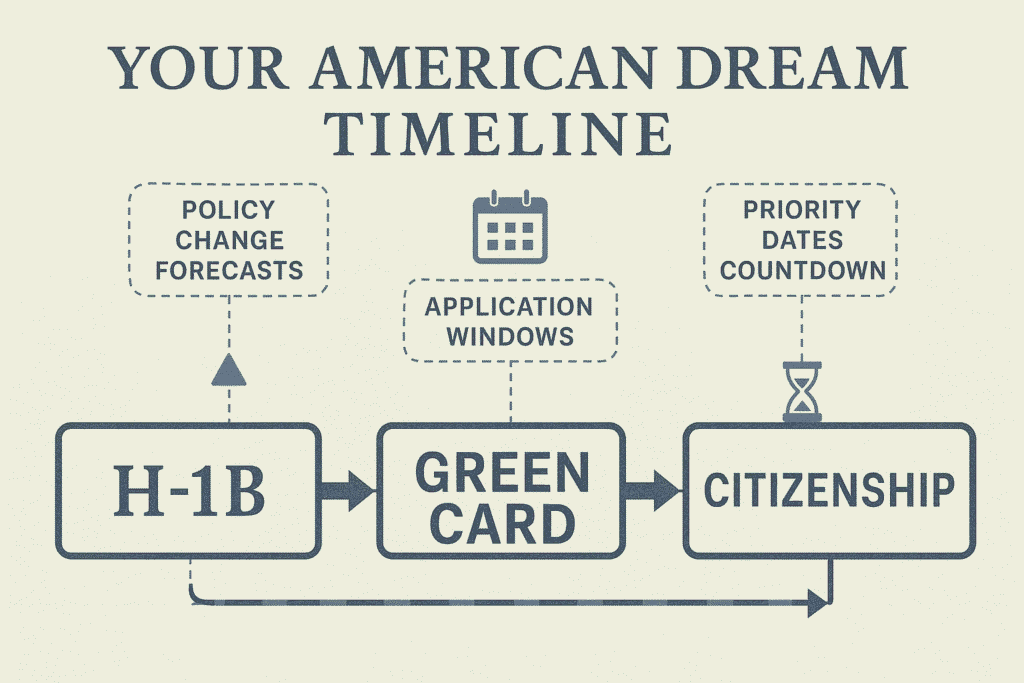
The H-1B visa program remains a cornerstone of America’s strategy to attract global talent, but the road ahead is being reshaped by technological disruption, policy reforms, and shifting economic priorities. For international professionals considering or currently on an H1-B visa, understanding these emerging trends is crucial for long-term career planning.
1. Sustained Demand in Core Sectors
The U.S. labor market will continue relying on H1-B talent in these high-growth areas:
Technology & AI Development
- Artificial intelligence specialists will see 32% growth by 2030 (BLS).
- Cybersecurity roles are expanding as threats become more sophisticated.
- Quantum computing emerging as a new visa sponsorship category
Healthcare Transformation
- Telemedicine creating remote opportunities for foreign doctors
- Geriatric care specialists needed for aging population
- Biotech research driving demand for PhD-level scientists
Green Energy Revolution
- Renewable energy engineers for solar/wind infrastructure projects
- EV Battery Technology experts as the auto industry transforms
- Climate tech roles in carbon capture and sustainability
2. Policy Changes on the Horizon
Several developments could reshape the H-1B landscape:
- Potential lottery reforms prioritizing higher salaries/advanced degrees
- Expansion of premium processing to reduce uncertainty
- Stronger wage protections to prevent undercutting domestic workers
- Possible STEM exemptions for certain advanced degree holders
Pro Tip: Subscribe to USCIS updates and follow immigration attorneys on LinkedIn for real-time policy alerts.
3. The Remote Work Revolution’s Impact
Hybrid work models are creating new possibilities:
- More companies sponsoring fully remote H1-B workers
- “Digital nomad” visas potentially competing with H1-B
- Reduced need for geographic relocation in some sectors
4. Salary Trends & Compensation Packages
Expect these financial developments:
- Tech salaries continue to lead at $120,000−$250,000+ for senior roles.
- Healthcare seeing 10-15% premium for specialists in underserved areas
- Increased equity/stock options as retention tools
- More performance-based bonuses replacing guaranteed pay
5. Alternative Pathways Gaining Prominence
Savvy professionals are exploring:
- O-1 visas for those with extraordinary abilities
- EB-2 NIW self-petitions for qualified individuals
- L-1 transfers through multinational companies
- Startup visas under international entrepreneur rules
6. The Long-Term Green Card Challenge
Backlogs remain the elephant in the room:
- Indian nationals face decade-long waits in EB-2/EB-3 categories.
- Possible legislative solutions being debated in Congress
- Importance of employer portability provisions
Strategic Recommendations for Future Success
To thrive in this evolving environment:
- Develop Hybrid Skill Sets – Combine technical expertise with business/communication skills.
- Build Multiple Income Streams—Consultancy, teaching, or content creation within visa rules
- Cultivate Transferable Credentials—Licenses/certifications recognized across states/industries
- Establish Local Professional Networks—Through meetups, conferences, and industry associations
For those considering options beyond traditional H1-B paths, our guides on Healthcare Jobs in the USA with Visa Sponsorship and High-Paying Jobs for Skilled Workers provide valuable alternatives.
Final Thought: Positioning Yourself for Success
While challenges exist, the fundamental reality remains unchanged: America needs skilled global talent. By staying adaptable, continuously upskilling, and making strategic career moves, H1-B professionals can build rewarding, long-term careers in the United States.
The most successful applicants will be those who view the H1-B not just as a work visa but as the first step in a carefully planned American career journey.
9. Conclusion & Next Steps
Securing a job in the USA as an H1-B visa holder is both an exciting opportunity and a significant challenge. Throughout this guide, we’ve explored the evolving job market trends, top industries hiring international talent, and strategies to navigate the complex visa sponsorship process. While the path requires dedication, the rewards—professional growth, competitive salaries, and life-changing experiences—make the effort worthwhile.
Key Takeaways from This Guide
- The H1-B Visa Remains a Vital Pathway— Despite policy fluctuations, U.S. employers continue to rely on skilled foreign professionals, particularly in technology, healthcare, engineering, and finance.
- Specialized Skills Trump General Experience—The most successful candidates develop niche expertise that sets them apart in competitive fields.
- Networking is Just as Important as Qualifications—Many H1-B opportunities are filled through referrals and professional connections rather than public job postings.
- Persistence Pays Off—From the visa lottery to job interviews, resilience is often the difference between success and disappointment.
Your Action Plan: Turning Knowledge into Results
1. Revamp Your Professional Materials
- Resume Optimization—Tailor your resume with keywords from job descriptions and highlight achievements with metrics (e.g., “Improved system efficiency by 30%”).
- LinkedIn Profile Update—Ensure your profile clearly states your visa status and desired sponsorship. Join industry-specific groups to increase visibility.
- Cover Letter Customization—Address visa sponsorship proactively: “As an international professional requiring H1-B sponsorship, I bring [specific skills] that align perfectly with your needs for [specific role].”
2. Execute a Multi-Channel Job Search
- Leverage Specialized Platforms—Regularly check H1B Grader, MyVisaJobs, and LinkedIn’s visa sponsorship filters.
- Engage Recruiters—Reach out to staffing agencies that specialize in visa placements (e.g., Kforce, Randstad).
- Explore Hidden Opportunities—Many roles are never advertised. Use platforms like Meetup to connect with professionals at target companies.
3. Build Strategic Relationships
- Alumni Networks—Contact graduates from your university working at U.S. companies. A simple message like, “I noticed you made the transition to [Company]—would you have 15 minutes to share your experience?” can open doors.
- Industry Events—Attend virtual or in-person conferences (e.g., Grace Hopper for tech, AMA events for healthcare).
- Informational Interviews: To find out about unlisted positions, ask specialists in your sector to give you a quick call.
4. Prepare for the Visa Process
- Document Organization—Gather diplomas, transcripts, and reference letters now to avoid delays later.
- Employer Education—Be prepared to explain the H1-B process to potential sponsors—many smaller companies don’t realize how straightforward it can be.
- Backup Plans—Consider alternatives like Day 1 CPT programs or L-1 transfers if the H1-B lottery doesn’t go your way.
Looking Beyond the H1-B
While this visa is a critical first step, long-term success often depends on
- Green Card Planning—Discuss PERM labor certification timelines with employers early in the hiring process.
- Skill Development—Continuously upgrade your expertise to remain indispensable.
- Community Building—Connect with other H1-B professionals through organizations like Immigrants Rising for support and resources.
For those exploring alternative options, our in-depth guides on Healthcare Jobs in the USA with Visa Sponsorship and High-Paying Jobs for Skilled Workers provide additional pathways to consider.
Final Encouragement
The journey to U.S. employment as an H1-B holder tests your patience and perseverance, but thousands of professionals navigate it successfully each year—and you can too. By combining the insights from this guide with consistent effort, you’ll maximize your chances of joining the ranks of international talent thriving in America.
Your American dream starts with one bold step forward—take it today.


